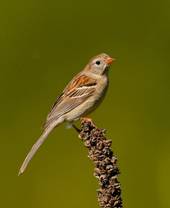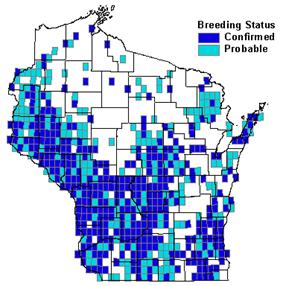

Status/Protection
- Global Rank: G5 Key to global and state ranks
- State Rank: S4B
- WBCI Priority: PIF, SGCN, State Special Concern
Population Information
The Federal BBS information can be obtained at http://www.mbr-pwrc.usgs.gov/bbs/bbs.html by clicking on Trend Estimates and selecting the species in question. All estimates are for time period (1966-2005).
- Federal Breeding Bird Survey: significant decline
- Federal Breeding Bird Survey (WI): significant decline
- Federal Breeding Bird Survey (BCR 23): significant decline
- Federal Breeding Bird Survey (BCR 12): significant decline
- WSO Checklist Project: significant decrease (1983-2007)
Life History
- Breeding Range: Primarily the states east of the Rockies and parts of southern Canada (Carey et al. 1994).
- Breeding Habitat: Dry Prairie, Dry-mesic Prairie, Idle Cool-season Grasslands, Pine Barrens, Oak Barrens, Oak Opening, Idle Warm-season Grasslands, Pasture, Grassland-shrub.
- Nest: small neat grass cup lined with finer material that sits on top of grass clumps on the ground or are set in small woody shrubs no more than 1 meter off the ground Baicich and Harrison (1997).
- Nesting Dates: May-August.
- Foraging: Forage on mostly seeds and to a lesser extent on insects. Forage on ground or in small shrubs.
- Migrant Status: Short-distance migrant.
- Habitat use during Migration: similar to breeding habitat, occasionally suburban yards.
- Arrival Dates: April.
- Departure Dates: September-October.
- Winter Range: Kansas to Illinois to Atlantic coast south to Gulf of Mexico and Northern Mexico.
- Winter Habitat: abandoned agriculture fields, grazed fields, forest edges, fencerows.
Habitat Selection
Field Sparrows are a dominant species in dry upland sites such as Grassland-shrub, dry prairie, barrens, cut and burned-over areas, young conifer plantations, and woody edges. They are also common in pasture, idle grasslands, dry old fields, oak savannah (Sample and Mossman 1997), woodland openings, roadsides, and railroad right of ways (Carey, Burhans, and Nelson 1994) if proper woody vegetation is available for nesting (1-25% shrubs/saplings) (Sample and Mossman 1997). However, the population in an area decreases as trees and thickets become more dominant (Carey, Burhans, and Nelson 1994). Field Sparrows avoid suburbs preferring the countryside. They nest on the ground or in the woody vegetation <1m tall. Field Sparrow’s field size requirements are small (found in fields as small as 15 acres) (Knutson etal 2001).
Habitat Availability
Field Sparrows are a common breeder in southern and western portions of Wisconsin but are very rare in the north and east (Robbins 1991). Cut or burned-over areas and young conifer plantations are commonly nested in. Pastures and dry old fields are also common but vulnerable to conversion with the intensification of agriculture. Conservation Reserve Program (CRP) has greatly increased the amount of idle grasslands for birds to use during the breeding season (Reynolds et al. 1994 and Johnson and Igl 1995) and has been found to be used frequently by Field Sparrow (McCoy 1999) . Grassland-shrub, dry prairie, barrens, idle grasslands, and oak savannah are rare and vulnerable to conversion to row crops, or succession to forest. Further restriction is placed on these habitats requiring adequate shrub content for Field Sparrows to nest in (Sample and Mossman 1997). Woodland openings, roadsides, and railroad right of ways are fairly common and stable but the exact amount of this habitat that persists in Wisconsin is unknown.
Population Concerns
In the portions of the state within Field Sparrow nesting range, the species appears fairly common (Robbins 1991). However, Field Sparrow is still designated as a species of management concern (Sample and Mossman 1997). Sample and Mossman (1997) ranked Field Sparrows within the top 10 ranked bird species that have management priority for the state of Wisconsin. Field Sparrow nests are commonly parasitized by Brown-headed Cowbirds. These nests are often deserted reducing nest productivity. However, those birds accepting the cowbird egg have not shown lower survivorship of host young or increase in predation. McCoy et al. (1999) found that CRP fields in north central Missouri supported a stable population of Field Sparrow in at least 2 of the 3 years of their study. The population of Field Sparrows will largely depend on habitat availability. (Carey et al. 1994).
Recommended Management
Management practices that maintain open grassland while keeping shrubs will maintain Field Sparrows. Burning once every 5+ years maintains the grassland without eliminating the shrub content. Grazed pastures that maintain shrub component is also an attractive option for Field Sparrows. Frequent mowing and burning are not recommended because they reduce the necessary shrub layer (Sample and Mossman 1997), but mowing done in a way that chooses the best mix of open grass to shrub component could be more beneficial than burning. Field Sparrows are found on smaller sites, so maintain Grassland-shrub communities on smaller sites that have less opportunity for other grassland species is recommended. In addition, oak opening restorations should maintain patches of shrubs within the site for this and other shrub species.
Research Needs
Further investigation on what existing landscapes are considered a source for Field Sparrow populations is needed. Evaluating current management practices in grassland/barrens wildlife areas with respect to this and other priority species is of high priority.
Information Sources
- Richard Henderson Wisconsin DNR.
- David Sample, Grassland Community Ecologist, Wisconsin DNR Research Center, 1350 Femrite Dr., Monona, WI 53716.
- North American Breeding Bird Survey: http://www.npwrc.usgs.gov
- Temple S. A., J. R. Cary, and R. Rolley. 1997. Wisconsin Birds; A Seasonal and Geographical Guide. Wisconsin Society of Ornithology and Wisconsin Department of Natural Resources, Madison, WI.
- Wisconsin Breeding Bird Atlas: http://www.uwgb.edu/birds/wbba/
- USGS website for Field Sparrow: http://www.mbr-pwr.usgs.gov
References
- Baicich, P. J., and C.J. O. Harrison. 1997. A guide to the Nests, Eggs, and Nestlings of North American Birds. 2 nd ed., Academic Press, San Diego, CA.
- Carey, M., D. E. Burhans, and D. A Nelson.1994. Field Sparrow (Spizella pusilla). In the Birds of North America, No. 103 (A. Poole and F. Gill eds.). Philadelphia: The Academy of Natural Sciences; Washington, D.C.: The American Ornithologists’ Union.
- Johnson, D.H., and L. D. Igl. 1995. Contributions of the Conservation Reserve Program to populations of breeding birds in North Dakota. Wilson Bulletin 107: 709-718.
- Knutson, M. G., G. Butcher, J. Fitzgerald, and J. Shieldcastle. 2001. Partners in Flight Bird Conservation Plan for The Upper Great Lakes Plain (Physiographic Area 16). USGS Upper Midwest Environmental Sciences Center in cooperation with Partners in Flight. La Crosse, WI.
- McCoy, T. D. , M. R. Ryan, E. W. Kurzejeski, and L. W. Burger Jr. 1999. Conservation Reserve Program: Source or Sink Habitat for Grassland Birds in Missouri? Journal of Wildlife Management. 63(2) 530 – 538.
- Reynolds, R.E., T. L. Shaffer, J.R. Sauer, and B.B. Peterjohn. 1994. Conservation Reserve Program: benefit for grassland birds in the northern plains. Transactions of the North American Wildlife and Natural Resources Conference 59: 328-336.
- Robbins, S. D., Jr. 1991. Wisconsin Birdlife: Population and distribution past and present. Madison, WI: Univ. Wisconsin Press.
- Sample, D. and M. Mossman. 1997. Managing Habitat for Grassland Birds: A Guide for Wisconsin. Wisconsin Department of Natural Resources: Madison, WI.
Contact Info
- Compiler: Jenny Herrmann, mherrmann4@wi.rr.com
- Editor: Susan M. Vos comments submitted by Richard Henderson
